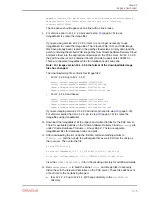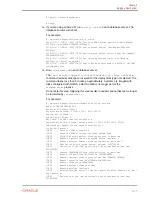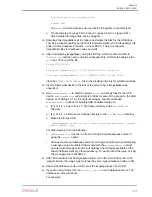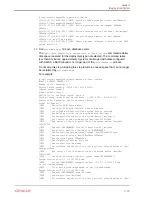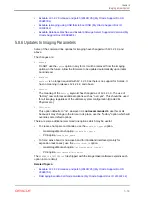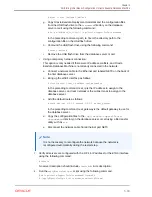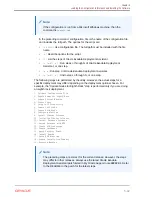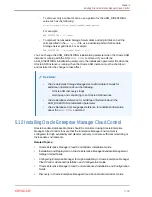
Valid. Booted: Linux. Layout: Linux.
If the system is an Oracle VM deployment, the last line of output will be the
following:
Valid. Booted: DOM0. Layout: DOM0.
6.
Copy Oracle Exadata Database Machine Deployment Assistant to the database
server using one of the following methods. If adding only cell servers, the steps
can be run from a cell.
•
Using a USB flash drive on Linux:
a.
Copy the configuration file to a USB flash drive.
b.
Connect the USB drive to the database server or cell.
c.
Locate the USB drive using the following command:
for x in `ls -1 /sys/block`; do udevadm info --attribute-walk --
path=/sys/block/$x | grep \
-iq 'DRIVERS=="usb-storage"'; if [ $? -eq 0 ] ; then echo /dev/${x}1; \
fi ; done
The expected output is similar to:
/dev/sdb1
Note:
If an X6 or X5 EF cell is used, the command will also return the two internal
USB drives, usually
/dev/sda1
and
/dev/sdb1
. The newly inserted USB
drive will be the additional device, usually
/dev/sdc1
.
The expected output is similar to:
/dev/sda1
/dev/sdb1
/dev/sdc1
The internal USBs can be identified by viewing
mdstat
:
# grep md4 /proc/mdstat | awk '{print $5,$6;}'
d.
Create a directory on the database server or cell using the following
command:
# mkdir /mnt/usb
e.
Create a directory for the installation using the following command:
# mkdir /opt/oracle.SupportTools/onecommand
If the directory already exists, then rename the existing one to
onecommand.old
, and then re-create the empty directory.
Note: Do not use a directory under
/u01
or
/EXAVMIMAGES
because
reclaimdidsks.sh
will fail if there is content in those directories.
f.
Mount the device. Use the device name given in step
(page 5-87). The
following is an example of the command.
Chapter 5
Performing Initial Elastic Configuration of Oracle Exadata Database Machine
5-87



